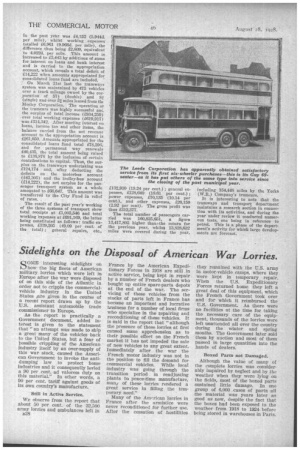Sidelights on the Disposal of American War Lorries.
Page 12

If you've noticed an error in this article please click here to report it so we can fix it.
SOME interesting sidelights on how the big fleets of American military lorries which were left in Europe after the war were disposed of on this side of the Atlantic in order not to cripple the commercialvehicle industry in the United States are given in the course of a recent report drawn up by the U.S. assistant automobile trade commissioner to Europe.
As the report is practically a Government document, added interest is given to the statement that "an attempt was made to ship a great many of the vehicles back to the United States, but a fear of bossible crippling of the American industry itself by an over-supply of this war stock, caused the American Government to invoke the antidumping law to protect home industries and it consequently levied a 90 per cent, ad valorem duty on this material." In other words, a 90 per cent. tariff against goods of its own country's manufacture.
Still in Active Service.
We observe from the report that about 50 per cent, of the 32,500 army lorries and ambulances left in B28
France by the American Expeditionary Forces in 1918 are still in active service, being kept in repair by a number of French dealers who bought up entire spare-parts depotsat the end of the war. The servicing of these vehicles from the stocks of parts left in France has become an important and lucrative business for a number of local firms who specialize in the repairing and reconditioning of these vehicles. It is said in the report that "although the presence of these lorries at first caused some apprehension as to their possible effect on the French market it has not impeded the sale of new vehicles to any great extent. Immediately after the war the French motor industry was not in the position to fill the demand for commercial vehicles. While local industry was going through the transition period in readjusting plants to peace-time manufacture, many of these lorries rendered a great service in filling the ternpora.ry need."
Many of the American lorries in France after the armistice were never reconditioned for further use. After the cessation of hostilities
they remained with the U.S. army in motor-vehicle camps, where they were kept in temporary repair. When the U.S. Expeditionary Forces returned home they left a great deal of this equipment, which the French Government took over and for which it reimbursed the U.S. Government. As there were no facilities at the time for taking the necessary care of the equipment, thousands of the lorries were left unattended all over the country during the winter and spring months. The Government later sold them by auction and most of them passed in large quantities into the hands of dealers.
Boxed Parts not Damaged.
Although the value of many of the complete lorries was considerably impaired by neglect and by the weather when they were lying on the fields, most of the boxed parts sustained little damage. In one group of 6,000 cases of parts all the material was years later as good as new, despite the fact that the boxes had been exposed to the weather from 1918 to 1924 before being stored in warehouses in Paris.
































